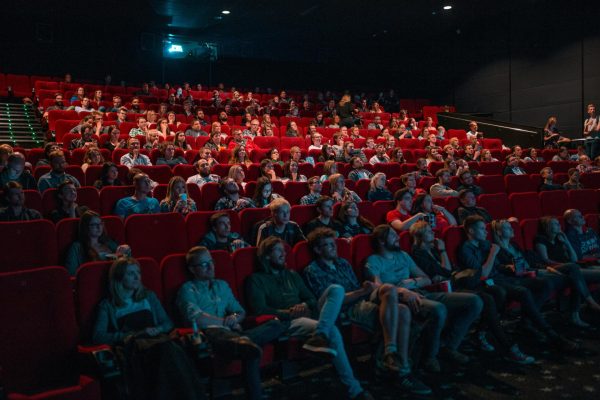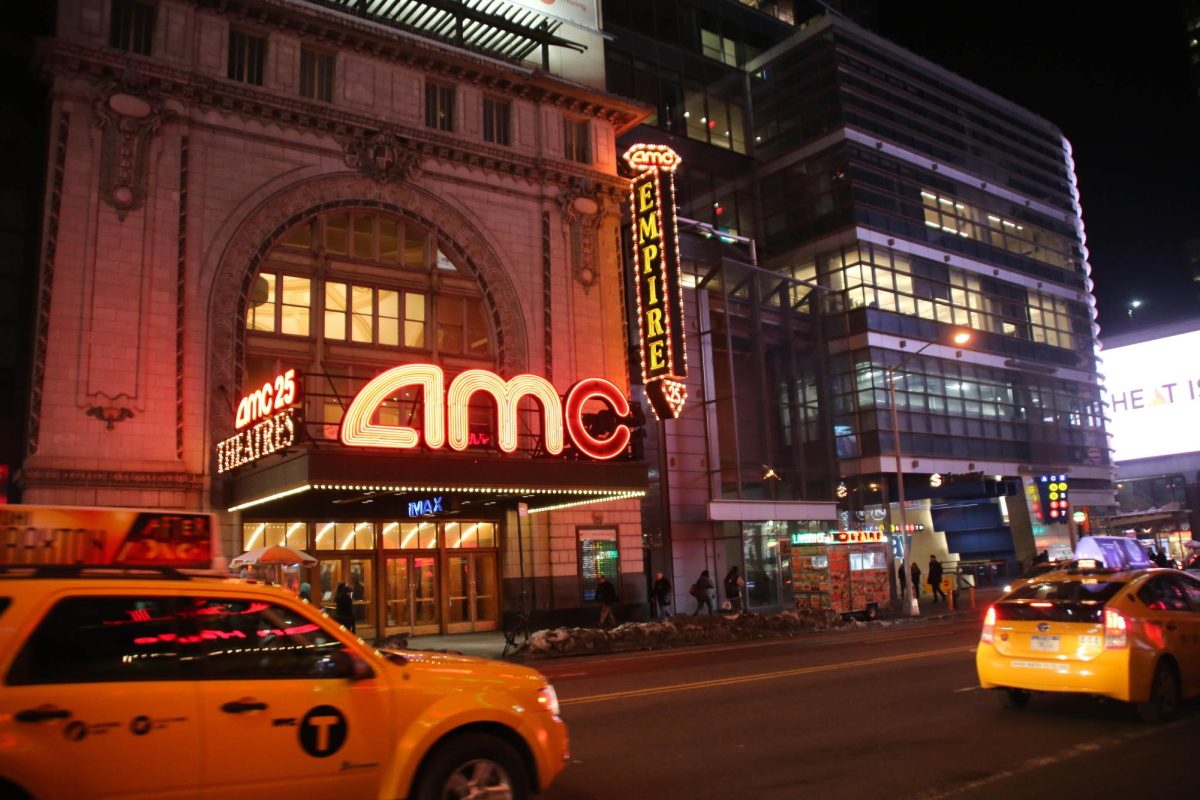The cool waves fan your face as you step into the familiar, yet disagreeable carpets of the AMC Theaters building. The delectable aroma of buttery popcorn, and the nearly overwhelming sweet scents of the candy with loud packaging all whirl into a myriad of experiences.
As you settle down into the theater, the female voice that has introduced the beginning of every nostalgic film says, “…And with that, enjoy the show.”
AMC Theaters was created in 1920 by Edward D. Durwood, a struggling actor who hoped to pay his bills by opening a small theater in Kansas City. AMC was originally named Durwood Theaters, and Durwood would manage it with many of his children.
In 1920, Stanley Durwood was born. As the years went by, throughout the 1950s, Stanley Durwood would join his father and his siblings in taking care of Durwood Theaters.
The operation was relatively successful, with Durwood Theaters eventually becoming a chain of local movie houses and drive-in theaters.
In 1960, Edward D. Durwood passed away, leaving the business in the hands of Stanley Durwood and the rest of his siblings. Stanley would become the head of the business, and eventually, the business would grow into a nearly national corporation.
In 1963, Durwood finally realized his dreams of accomplishing a multiplex, a cinema with multiple theater screens displaying a variety of movies at the same time. The difficulty within the business was that there were already far more movie theaters with a greater reach that could lasso out for movie pictures with a greater reputation.
However, once the ball was rolling, Durwood realized the success of the theater.
In 1968, Durwood renamed the corporation into ‘American Multi-Cinema Inc.’ (AMC). At this point, AMC was a local chain of 12 theaters with 22 screens in total.
The 1980s was AMC’s growth spurt. As the cinema began to offer more than two or three screens at once, multiple audiences were being appealed to. Simple additions such as the cup holder (added in 1981) were complemented by the multitude of screens within one single theater.
As the company grew larger and larger, AMC would continue to show pictures of popular movie production companies, such as Disney, Pixar, Warner Bros, and so many more.
Undoubtedly, AMC has stood the test of time with movies. It is one of the most successful branches of corporations, appealing to nostalgia in far too many ways. In fact, it has callbacks of many successful movies, replaying some of the most popular pictures to appeal to multiple audiences.

AMC theater is held dear to our hearts as Generation Z because it represents our childhood.
According to Wynn Chang ’25, “I have childhood memories of my mom taking me and my brother out on a whim to AMC and just seeing whatever was available. It was one of my favorite things to do as a little toddler when you still hung out with your parents in that way — even though it was just such a simple, small moment.”
Going to the movie theater often brings joy, even if the experience is so simple. Simply watching a movie with loudspeakers and dark lighting could be accomplished anywhere.
However, the appeal of movie theaters is oftentimes the fact that it allows for effortless socialization. The collective gasps when a plot twist is revealed, and the shrieks of joy during the realization that the main character is in fact, not dead — simple interactions such as these remind us all that humans are so simple when finding joy within the little things.
It’s the same thing with concerts. Even though you can blast music anywhere, with atmospheric lighting within the room, the fact is that these experiences allow you to share vulnerable and sensitive moments with strangers, connecting you to these strangers with surprisingly warm and intense moments.
But it is increasingly difficult to do so when the appeal of movie theaters is falling apart, mainly because movie production companies, even the most popular ones such as Disney, are falling off.
In 1923, Walt Disney first produced his very first cartoon, Alice in Wonderland, in hopes that the franchise would branch off into something successful.
And successful it was.
Disney first began with cartoons, and eventually created the character we all know and love today, Mickey Mouse. Disney saw the opportunity to turn to merchandise, producing Mickey Mouse dolls, toothbrushes, backpacks, and so much more.
Disney would then begin to look towards the horizons of the film industry. Disney’s first film, Snow White and the Seven Dwarves, debuted on December 21st, 1937, and it became the highest-grossing film of all time.
Disney continued into its arch of success until 2014, in which Disney hit a 9-year low (The Ringer).
Why is that?
The reason why Disney is so successful is that all of its iconic characters are meant to teach important lessons that can be applied to both adults’ and children’s lives. For instance, the story of Beauty and the Beast teaches the message to never judge a book by its cover. Wall-E was meant to warn the future generations of the media and how dangerous upcoming inventions could be in the future.
Furthermore, “old Disney” captured escapism in the most perfect way. The tales of Cinderella, Sleeping Beauty, Toy Story, Tarzan, and so on — these movies were so popular because they were stories of fantasy mixed with small elements of realism.
The only recent Disney, Pixar, or any other children’s corporations’ movies that reached a high level of success were Frozen II (2019), Moana (2016), and Coco (2017).
Again, note that Frozen II was a sequel to the already popular franchise of Frozen.
Moana and Coco, on the other hand, are movies that provide the hints of escapism that old Disney provided. Moana delves into tales of Polynesian mythology with magical realms of water and fire. Coco reflects on the Day of the Dead, a popular Mexican holiday, but also incorporates the magical beliefs that the ancient Mexican rituals contained.
These movies are so successful because they involve mythologies of some sort that haven’t previously been explored. Moana and Coco are representative of minorities – but at the same time, still tell interesting tales by pushing the audience into a whole new world.
Additionally, the old Disney movies were during the developmental stages of the corporation itself. Disney had so many other competitors, such as Fleischer Studios and the Warner Brothers, that it recognized the necessity of quality and creativity within its artworks. Disney was a “start-up” and it was willing to take risks.

One of the recent Disney films, Wish, is a definite example of a movie that fails to entice audiences the same way that old Disney movies were able to.
Wish, a movie that marked the 100th anniversary of Disney, was an incredibly anticipated movie by many box offices. The movie was meant to have many nostalgic reminders, such as the idea of granting wishes, which has been a theme of Disney for a long time. The shooting star was yet another reminder of the Disney logo, which is a shooting star over a castle in the dark, night sky.
The problem with Wish is that it was far too reliant on this nostalgic value, when it is lacking in a lot of other values.
For instance, a key concept of Disney is the fact that the company has produced so many iconic songs. However, in Wish, the songs simply aren’t as lasting and incredible because the melodies are repetitive, and they don’t climax enough to a satisfactory emotion.
A specific song in particular, This Is the Thanks I Get?! was criticized for the redundant line of, “I let you live here for free and I don’t even charge you rent.”
“This Is the Thanks I Get?!” also showcases the lack of a proper villain in Wish. Previously, in other movies such as Tangled, Lion King, and 101 Dalmations, with Mother Gothel, Scar, and Cruella, respectively, all villains have an end goal.
Mother Gothel wants to remain youthful for the rest of her life, which is her reason for trapping Rapunzel in a tower.
Scar wishes to overtake Mufasa’s throne as king, which is why he not only kills Mufasa, but also starts an uproar within the savanna against Simba.
Cruella wants to skin the 101 Dalmations for their fur, as she sees the value in the fur for her fashion projects.
All three of the iconic villains fulfill some sort of greed, envy, and pride. They all exemplify some form of evil.
However, King Magnifico of Wish is a bland villain. He doesn’t receive a particularly motivating factor other than feeling insulted by the lack of respect from the civilians that he rules over. His motivations are petty at most, and he doesn’t have a particular goal that he wishes to achieve other than being cruel to the civilians of his kingdom.
Furthermore, many have commented on Wish’s animation, which doesn’t feel particularly unique or dimensionally reasonable.
Wish seems to attempt to recreate the old 2D animation style that its iconic movies had, such as Sleeping Beauty and Cinderella, while also creating a 3D animation – but this led to an uninspiring and confusing art style.
Disney is only one of the few animation studios that have stood against the test of time. But the question comes as to whether the animation studio will be able to continue doing this.
Far too many people have protested against the rebranded Disney, where it is uninspiring, and rare for the movies to hit in the same manner as they have in the past.
Of course, this isn’t meant to only comment on Disney’s downfall. Disney is simply one of the most prominent industries that are worth commenting on. But perhaps we should stop worrying about the ‘cancel culture’ that is so prevalent throughout social media, and worry more about the future of the entertainment industry in regards to the generations.
According to Wynn Chang ’25, “I have childhood memories of my mom taking me and my brother out on a whim to AMC and just seeing whatever was available. It was one of my favorite things to do as a little toddler when you still hung out with your parents in that way — even though it was just such a simple, small moment.”

